Planting and caring for morning glory: how to grow a colorful liana
Morning glory is an amazing climbing plant that allows you to show creativity and imagination in terms of garden decor. The flower, about which the poems were composed, are rightfully considered the favorites of landscape designers.
Content:
- Morning glory: all the details about the genus
- Morning glory: popular varieties
- How to grow a vine from seeds
- Correct planting of seedlings
- Morning glory care
- The main threats to plant health
Morning glory: all the details about the genus
Ipomoea belongs to the numerous Bindweed family that spread from tropical America. The genus Ipomoea consists of 500 different species. Only 25 are considered cultural.
Representatives are grasses, shrubs, small trees, but mainly vines. The genus also includes food species: sweet potato and aquatic spinach. Back in the distant eighteenth century, gardeners began to use a plant for decoration... Fabritis attracted attention with the ability to develop quickly and bloom generously, turning a small area into a colorful carpet.
The name "morning glory" has Greek roots. The exact translation means "worm-like".
This definition is justified: getting rid of creeping roots and stems is quite problematic. At home, some plant species are considered stubborn weeds. Gardeners cultivate vines, whose corollas open early in the morning or in the evening. Other, romantic names of plants - "morning dawn flower", "night glow", "moon flower".
Having met the sunrise, by noon the corollas close the petals and wither. In cloudy weather, they can hold out until the evening, but no longer than one day. This is not a reason for frustration, because in the place of one wilted flower, 1-2 new ones immediately appear.
Description of the plant:
- The stem of the plant is densely leafy, heart-shaped. Morning glory can "conquer" a height of up to 3 m.
- Funnel-shaped corollas similar to a gramophone tube are large and fragrant.
- The palette is very diverse: the color is white, blue, blue, pink-red, deep purple.
- The diameter of the flowers is from 4 to 15 cm.
Morning glory pleases the eye with colors with the arrival of summer... In October, with the onset of the first frost, flowering stops. This is the ripening time for the fruits - small round boxes filled with black seeds. Liana, beloved by gardeners, is a generous plant that is famous for its long and abundant flowering.
Morning glory: popular varieties
Different types of flowers differ from their counterparts in the shade and shape of the corollas, the size of the foliage.
Common vines:
- Morning glory tricolor. An American perennial cultivated as an annual plant. On a long stem (up to 5 m) there are large, wrinkled leaves. The delicate blue color of young flowers changes to fading pink-purples. Three or four large funnel-like corollas form a tuft.
- Ipomoea ivy. The American plant gets its name from the three-lobed leaves that ivy also has. It grows up to 2-3 m. From early summer to mid-autumn, the garden is decorated with blue, red, burgundy or pink funnel-like flowers.
- Ipomoea moon-flowering. The long stem (3 m) is crowned with large fragrant white flowers. They open up at nightfall and "fall asleep" when they meet the first rays of the sun.You can admire the liana in cloudy weather, when the corollas are open all day.
- Kvamoklites. Their peculiarity is openwork carved leaves, small tubular flowers.
- Ipomoea purple. Heart-shaped stem, rising by 2-3 m, covered with brown hairs. The leaves are the same shape. Corollas (3-6 cm in diameter) are blue, purple or white.
- Morning glory Nile. Liana branches strongly. Height - 3 m. The diameter of the flowers is about 10 cm. The color of large foliage is deep green.
There are tuberous varieties of Fabritis (sweet potatoes, sweet potatoes) that are used as a culinary ingredient.
The leaves of some morning glories are a substitute for spinach. Vines are known that affect human consciousness. Documentary evidence of the use of plant seeds as a psychoactive substance dates back to the end of the colonial period. Ipomoea delights with a variety of varieties, among which there are both traditional and mysterious.
How to grow a vine from seeds
Little tricks in growing:
- The collected planting material retains its properties for 3-4 years. Sow it, waiting for the middle of May.
- Preparatory procedure - scarification... The result is a violation of the integrity of the shell.
- The seeds can be soaked in warm (25-300 C) water. If swelling does not occur, the sheath is damaged with a needle. The processed raw materials are returned under water.
- Some difficulties arise when preparing the substrate: each species has its own preferences in this regard. African varieties like succulent soil, which has been added with crushed expanded clay.
- "Americans" in such soil will not be comfortable. They need a mixture: 2 parts of leaf humus, peat, vermiculite, coconut milk - 1 part each, small expanded clay - 0.5 part. The prepared substrate is filled into cups. No more than 2-4 seeds are placed in each. Covering the top with glass or plastic, make a small greenhouse.
- The soil is watered as needed. Ventilate, remove condensate. With a favorable temperature regime (18-200 C), seedlings will appear after 10-12 days.
- Seedlings that have grown up to 15 cm want to trail. The base of the plant is tied with a cord. The other end of the rope is pulled up and fixed.
Developing bindweed need periodic transplantation into a large container. The transshipment method will allow you to do this carefully, without injuring or exposing the roots. Pinching seedlings is a way to increase the number of side shoots.
Success can be achieved by sowing planting material directly into open ground. Such manipulations are performed in late April - early May. In a few weeks, the seedlings will appear from the hole. Having collected the seeds of morning glory, it is quite easy to grow young plants.
Correct planting of seedlings
In late spring or in the first weeks of summer, it's time to start planting flowers in a permanent place. This is the most favorable time: the soil has already warmed up, night frosts are not terrible.
Young vines are transplanted by transshipment. The distance between plants is 20 cm.
It is important to install the support immediately. In its capacity, a lattice of rods or a stretched line is used. Correctly chosen location for planting - the key to the successful development of the plant. Ipomoea will like it on the south, east or west side, she likes intense lighting. The liana, shaded towards the north, will not disappear either. The fact that the bindweed is bad will be "told" by the active growth of foliage with minimal flowering.
Delicate and delicate fabritis do not tolerate wind well. He is able to clothe them from support and disheveled. In general, the flower does not have any special requirements for the soil. The ideal option is nutritious, loose, well-drained soils. The competent planting of a young morning glory in a suitable place will allow you to admire the riot of its colors throughout the summer.
Morning glory care
Liana, like any plant, needs some care. Care activities include:
- Vertical support design
- Regular weeding
- Sufficient watering
- Timely feeding
- Pruning
- Topping
Bindweed does not tolerate when water stagnates in the ground. It is drunk in moderation so that the rhizome does not rot due to excessive moisture. From the end of spring and throughout the summer, the flower is watered without waiting for the earth to dry out. With the onset of autumn, this is done when the soil is completely dry. For lianas, drought is no less destructive. She will react to this state of affairs by lifelessly hanging the leaves. It is impossible to bring the plant to dehydration: after watering it will recover, but the immunity will no longer be the same. This is a direct threat to the development of diseases.
During active growth, Ipomoea fertilizers needed... Use formulations for decorative growing crops or for succulents. After feeding the plant, they wait 2-3 weeks and do it again.
An overabundance of nutrients, especially with a high nitrogen concentration, will manifest itself as overgrowth of foliage. Morning glory in this case will not bloom.
Fabritis quickly stretches upward: 3-4 weeks after planting, he needs to establish a strong support. This can be a pergola, vertical wire or trellis net. Pinching the top of the stem will help a weak, unpresentable flower. After the procedure, lateral shoots will begin to form. Liana will regain her attractiveness.
Periodically, the plant needs pruning. Its purpose is to remove injured or unhealthy-looking shoots. They work in September.
In the spring, pruning is used to thin out the bush. A maximum of 3 stems are left on each individual. In some cases, the procedure is carried out during the growing season. In principle, the morning glory, unpretentious to care, has certain characteristics of growth.
The main threats to plant health
Bindweed is susceptible to fungal and viral diseases. In the first case, the source of infection is chronically wet soil.
Ipomoea can be cured of some fungi by removing the affected plant parts and applying a fungicide. It will not be possible to save the flower if it is overcome by rot (soft, root, stem). A sick morning glory will have to be destroyed.
You can't just get rid of viruses just like that. Sick vines are burned so that the infection does not spread to healthy individuals.
White edema damages flowers grown in a greenhouse or indoors. The reasons for the development of the disease: constantly wet soil, damp air, low temperature. Acting simultaneously, these factors lead to the formation of blisters and bumps on the foliage. Over time, their yellow or green color changes to brown. Further, it is even worse - the affected parts of the plant turn yellow and fall off.
Perceptible harm is done to vines aphids and spider mites. They are fighting with insecticides. Compliance with the rules of growing morning glory is the main means of preventing its diseases. The lush greenery and colorful bloom of the morning glories were to the liking of gardeners. This flower is a versatile "accessory" in landscape design.
More information can be found in the video.







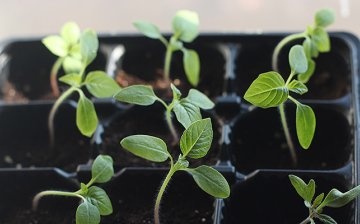










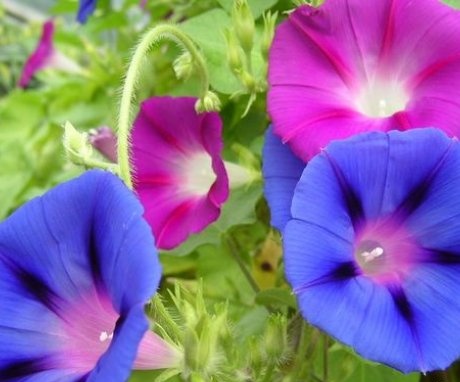
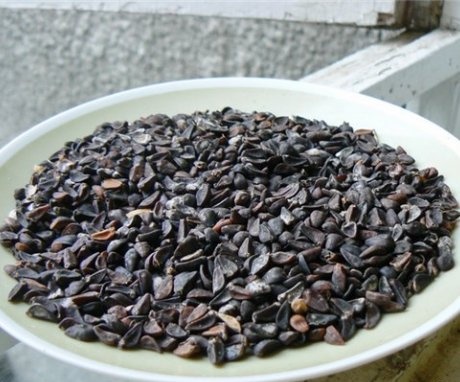
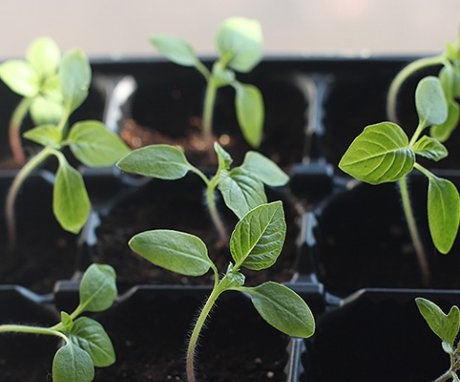
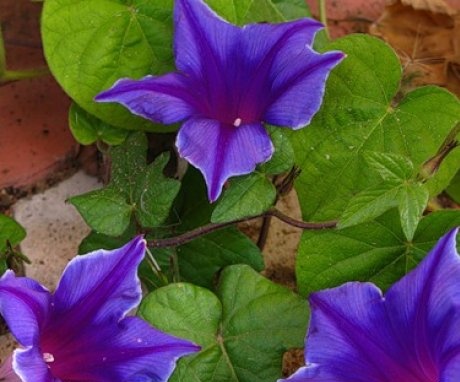
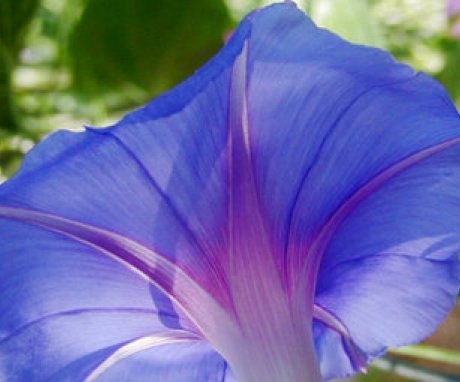
Honestly, I didn't even know. that she is so beautifully called - morning glory. I never thought about how to plant properly. She collected the seeds, sowed it directly into the ground in the spring without soaking and various tricks, and provided a wall along which it would trail. Unpretentious and surprisingly elegant.